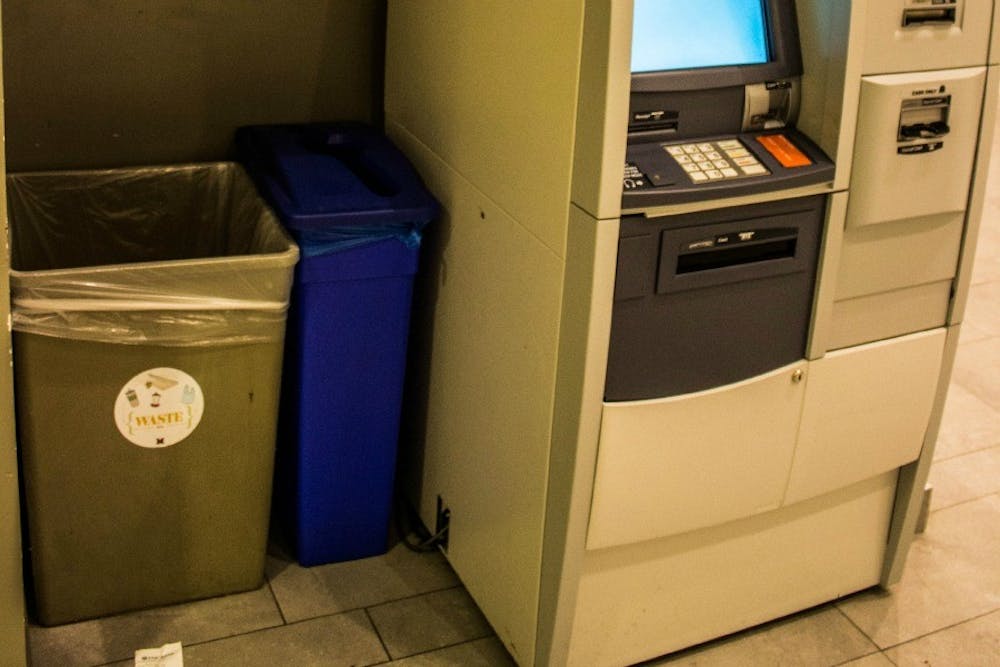By Tess Sohngen, For The Miami Student
The lack of recycling continues to plague visitors of the Armstrong Student Center (ASC) - despite student interest in recycling and the environment. But administrators see the tray return, hidden behind Serrano, as the optimal solution.
In a survey of almost 130 students conducted by an IES 511 class, 58 percent reported that not being able to find a recycling bin was a barrier to recycling, despite 91 percent saying that recycling is available to them on campus.
The survey indicated that the environment is important to most students (the average was 4.3 on a scale of 1-5, 5 being very important and 1 being not important), but many students are unsure of what items are recyclable or not, such as plastic bottle caps, paper coffee cups and the to-go containers at Armstrong.
The dining services employees who work in the dish room behind the tray return are trained to identify what is recyclable and what ought to be disposed.
Miami University's trash and recycling collector Rumpke weighs the total trash and recycling it picks up from campus four times a year. The company weighs the total amount of trash and recycling, not the individual weights of each building.
Yvette Kline, director of sustainability and energy conservation from the Department of Physical Facilities, shared the most recent weighs: Aug. 13 weighed in at 12.54 tons of recycling and 19.83 tons of garbage. The values increased to 17.18 tons of recycling and 57.16 tons of garbage on Nov. 2.
Where Miamians recycled approximately three items to every five they threw away in August, Miamians only recycled one third of how much they threw away in November. These values show that Miamians recycled more efficiently in the summer than during the semester.
The Department of Physical Facilities, Miami University Dining Services and ASC are collaborating on a recycling initiative that began this summer.
"We called it 'Landfill Diversion Committee and Brainstorming Session,'" said Katie Wilson, the Director of ASC.
Kline and Wilson see the tray return by Serrano, which is Armstrong's main recycling area, as the main solution.
"If things get to the tray return, you get maximum recovery," said Wilson. "If we get more things to the tray return, I think our recovery would go up."
But the tray return is often unused or overlooked by students who instead look for bins to throw out their trash and recycling. Its hidden location appears to be the biggest problem with the tray return.
Students have said to Wilson that in Bell Tower, another campus dining location, they don't notice that there are no trash cans because the tray return is on their way out.
"In Armstrong you have to backtrack and then go out, and there's nothing of its equivalent on the second floor for Pulley Diner," said Wilson.
Junior Anthony Young said that he does use the tray return but thinks more people would recycle if recycling bins were more visible.
"I think that most people are too busy walking in and out to put it in the recycling bin," said Young.
The committee working to increase the level of recycling in Armstrong is in the process of making the tray return and recycling bins more apparent and encouraging students to use them.
"We've talked about collaborating with orientations and new student programs to educate students on the tray return," said Wilson. "Especially since these orientations spend so much time in Armstrong."
The committee also posted blue arrows to point students toward recycling, left cards in the napkin holders encouraging students to use the tray return and sought to add containers that are more aesthetically pleasing and more obvious to students. They also added limericks inside study rooms with jingles like, "If you take it in, carry it out."
Across campus, the committee posted signs over trash and recycling cans indicating what is (or is not) recyclable, and issue that has plagued some of the committee's efforts to increase recycling. If the recycling bin has too many items that are not recyclable, the entire bag is put in the garbage.
Wilson stands by the initiative to minimize the number of garbage bins in Armstrong as part of a campus-wide initiative to reduce trash. She explained that this is why no garbage bins are located in study rooms in the Student Center, and she doesn't keep a trash bin in her office-only a recycling one.
"It's part of how we try to keep costs down and use the student fee money wisely," said Wilson. "If everyone pitches in a little and puts their trash in the hallway trash, it makes a big difference."

